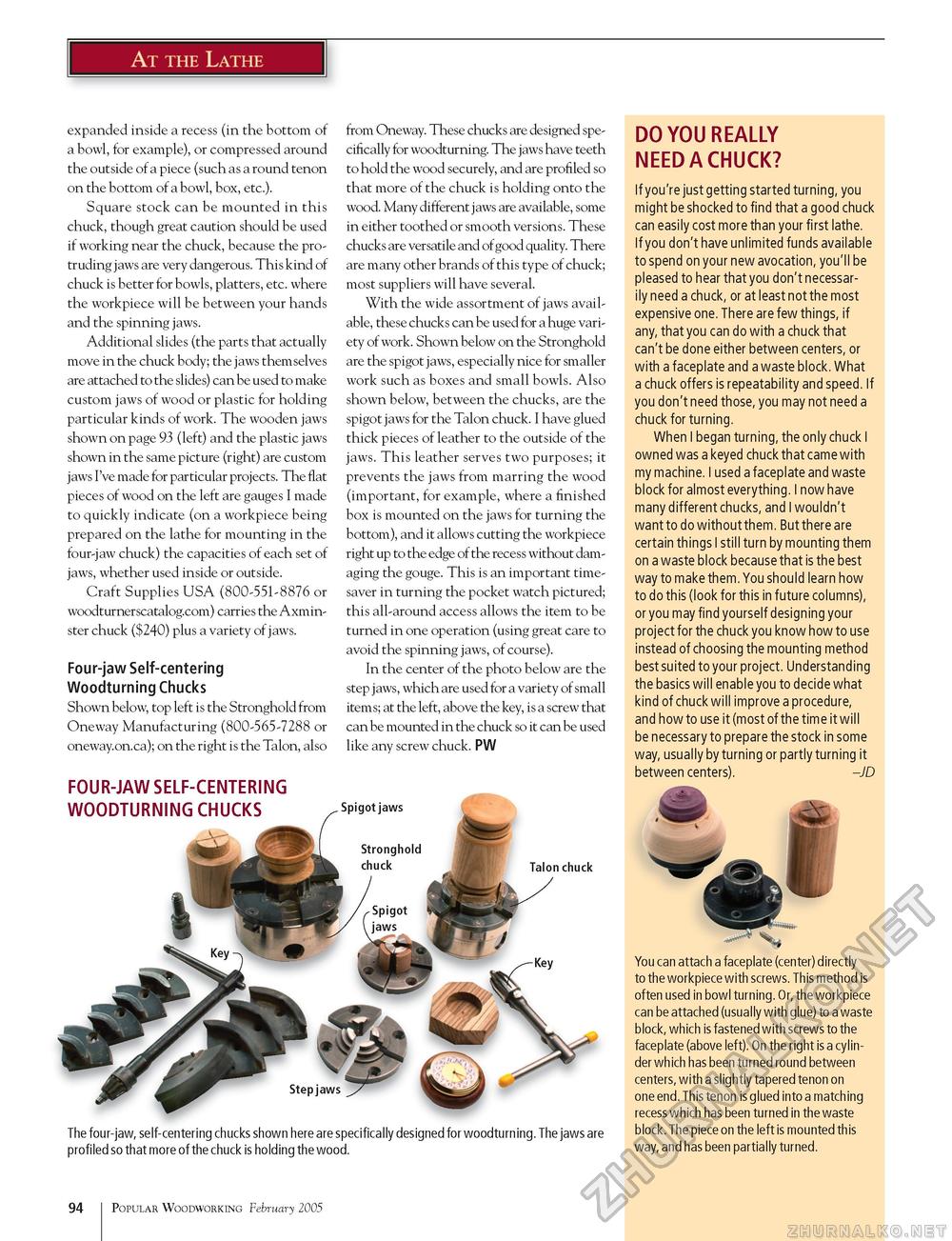Popular Woodworking 2005-02 № 146, страница 99
At the Lathe expanded inside a recess (in the bottom of a bowl, for example), or compressed around the outside of a piece (such as a round tenon on the bottom of a bowl, box, etc.). Square stock can be mounted in this chuck, though great caution should be used if working near the chuck, because the protruding jaws are very dangerous. This kind of chuck is better for bowls, platters, etc. where the workpiece will be between your hands and the spinning jaws. Additional slides (the parts that actually move in the chuck body; the jaws themselves are attached to the slides) can be used to make custom jaws of wood or plastic for holding particular kinds of work. The wooden jaws shown on page 93 (left) and the plastic jaws shown in the same picture (right) are custom jaws I've made for particular projects. The flat pieces of wood on the left are gauges I made to quickly indicate (on a workpiece being prepared on the lathe for mounting in the four-jaw chuck) the capacities of each set of jaws, whether used inside or outside. Craft Supplies USA (800-551-8876 or woodturnerscatalog.com) carries the Axmin-ster chuck ($240) plus a variety of jaws. Four-jaw Self-centering Woodturning Chucks Shown below, top left is the Stronghold from Oneway Manufacturing (800-565-7288 or oneway.on.ca); on the right is the Talon, also from Oneway. These chucks are designed specifically for woodturning. The jaws have teeth to hold the wood securely, and are profiled so that more of the chuck is holding onto the wood. Many different jaws are available, some in either toothed or smooth versions. These chucks are versatile and of good quality. There are many other brands of this type of chuck; most suppliers will have several. With the wide assortment of jaws available, these chucks can be used for a huge variety of work. Shown below on the Stronghold are the spigot jaws, especially nice for smaller work such as boxes and small bowls. Also shown below, between the chucks, are the spigot jaws for the Talon chuck. I have glued thick pieces of leather to the outside of the jaws. This leather serves two purposes; it prevents the jaws from marring the wood (important, for example, where a finished box is mounted on the jaws for turning the bottom), and it allows cutting the workpiece right up to the edge of the recess without damaging the gouge. This is an important time-saver in turning the pocket watch pictured; this all-around access allows the item to be turned in one operation (using great care to avoid the spinning jaws, of course). In the center of the photo below are the step jaws, which are used for a variety of small items; at the left, above the key, is a screw that can be mounted in the chuck so it can be used like any screw chuck. PW FOUR-JAW SELF-CENTERING \A/nnnTI IDMIMr: runri/c Spigot jaws The four-jaw, self-centering chucks shown here are specifically designed for woodturning. The jaws are profiled so that more of the chuck is holding the wood. DO YOU REALLY NEED A CHUCK? If you're just getting started turning, you might be shocked to find that a good chuck can easily cost more than your first lathe. If you don't have unlimited funds available to spend on your new avocation, you'll be pleased to hear that you don't necessarily need a chuck, or at least not the most expensive one. There are few things, if any, that you can do with a chuck that can't be done either between centers, or with a faceplate and a waste block. What a chuck offers is repeatability and speed. If you don't need those, you may not need a chuck for turning. When I began turning, the only chuck I owned was a keyed chuck that came with my machine. I used a faceplate and waste block for almost everything. I now have many different chucks, and I wouldn't want to do without them. But there are certain things I still turn by mounting them on a waste block because that is the best way to make them. You should learn how to do this (look for this in future columns), or you may find yourself designing your project for the chuck you know how to use instead of choosing the mounting method best suited to your project. Understanding the basics will enable you to decide what kind of chuck will improve a procedure, and how to use it (most of the time it will be necessary to prepare the stock in some way, usually by turning or partly turning it between centers). -JD You can attach a faceplate (center) directly to the workpiece with screws. This method is often used in bowl turning. Or, the workpiece can be attached (usually with glue) to a waste block, which is fastened with screws to the faceplate (above left). On the right is a cylinder which has been turned round between centers, with a slightly tapered tenon on one end. This tenon is glued into a matching recess which has been turned in the waste block. The piece on the left is mounted this way, and has been partially turned. 94 Popular Woodworking February 2005 |








